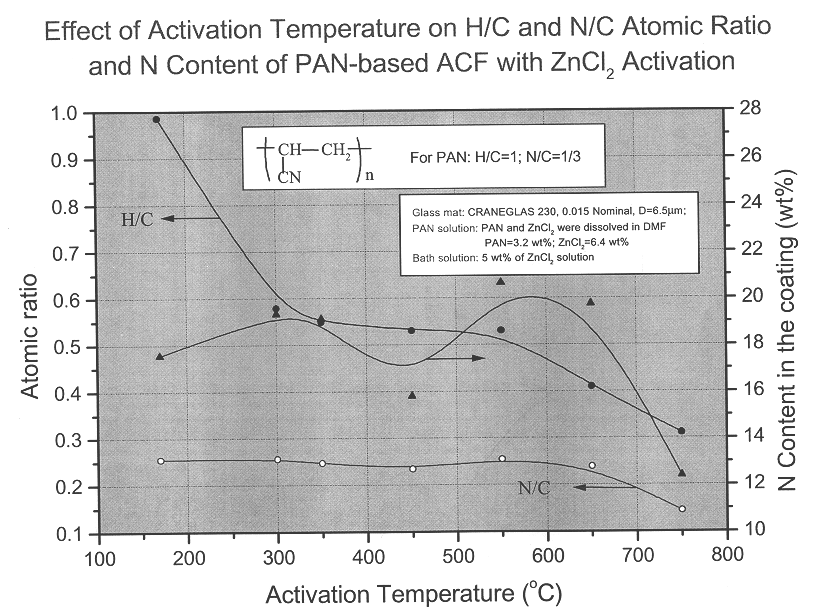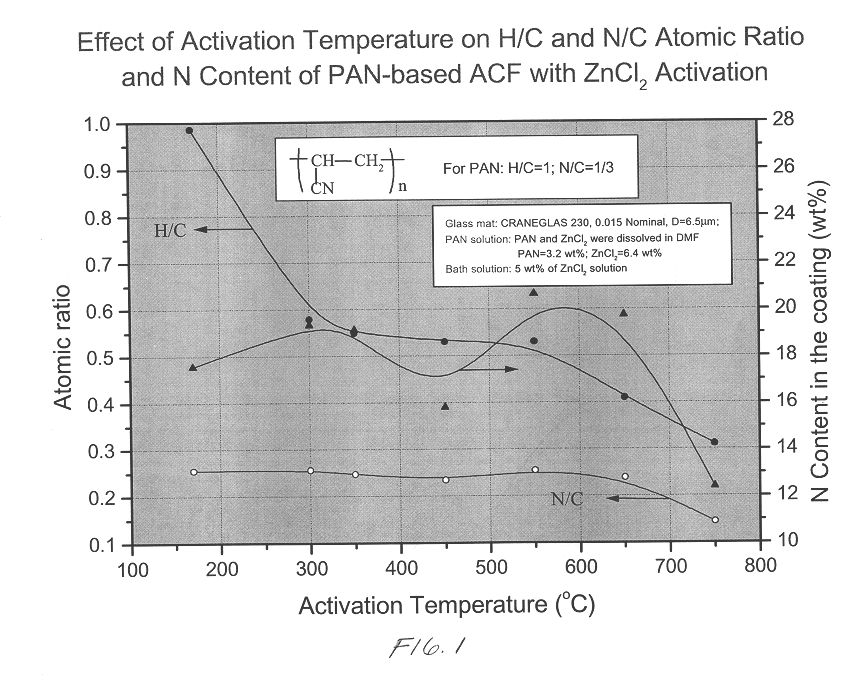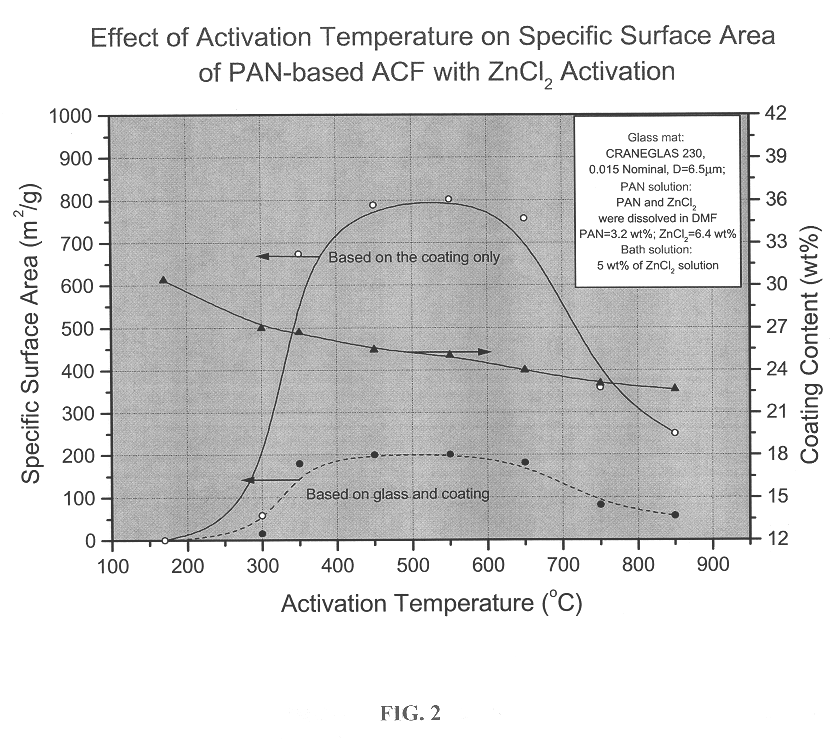Activated organic coatings on a fiber substrate
a technology of activated organic coatings and fiber substrates, which is applied in the direction of filtration separation, other chemical processes, separation processes, etc., can solve the problems of limiting the cost-effectiveness of activated carbon fibers, brittle or frangible activated carbon fibers, and limited methods
- Summary
- Abstract
- Description
- Claims
- Application Information
AI Technical Summary
Benefits of technology
Problems solved by technology
Method used
Image
Examples
example 1
Effect of Temperature on H, C, and N Content
PAN and ZnCl.sub.2 were dissolved in DMF, to give a mixture having a concentration of 3.2 wt % PAN and 6.4 wt % ZnCl.sub.2. A glass mat composed of CRANEGLAS 230, (0.015 nominal, fiber diameter of 6.5 .mu.m) was dip coated with the mixture. The coated fiber was passed through a 5 wt % of ZnCl.sub.2 solution bath, then dried and stabilized at the temperature range from 170 to 250.degree. C. for 6 h. The stabilized fiber was activated in N.sub.2 flow at different temperatures for 30 min, then washed with H.sub.2 O and HCl thoroughly and dried at 120.degree. C. under vacuum. H, C and N contents were measured with an elemental analyzer and TGA (thermogavimetric analysis). The results are shown in FIG. 1.
example 2
Effect of Activation Temperature on Surface Area
PAN and ZnCl.sub.2 were dissolved in DMF, to give a mixture having a concentration of 3.2 wt % PAN and 6.4 wt % ZnCl.sub.2. A glass mat composed of CRANEGLAS 230, (0.015 nominal, fiber diameter of 6.5 .mu.m) was dip coated with the mixture. The coated fiber was passed through a 5 wt % of ZnCl.sub.2 solution bath, then dried and stabilized at the temperature range from 170 to 250.degree. C. for 6 h. The stabilized fiber was activated in N.sub.2 flow at different temperatures for 30 min, then washed with H.sub.2 O and HCl thoroughly and dried at 120.degree. C. under vacuum. N.sub.2 BET surface area was measured with a QUANTACHROME AUTOSORB-1 and the coating content was measured with TGA. The results are shown in FIG. 2.
example 3
Effect of ZnCl.sub.2 Concentration on Specific Surface Area
PAN and ZnCl.sub.2 were dissolved in DMF, to give different mixtures having a ratio of weight of PAN: DMF: ZnCl.sub.2 =1: 23.61: X, where X is the ZnCl.sub.2 concentrations shown in FIG. 3. A glass mat composed of CRANEGLAS 230, (0.015 nominal, fiber diameter of 6.5 .mu.m) was dip coated with these mixtures. The coated fiber was passed through a 5 wt % of ZnCl.sub.2 solution bath. Then dried and stabilized at the temperature range from 170 to 250.degree. C. for 6 h. The stabilized fiber was activated in N.sub.2 flow at 350.degree. C. for 30 min, then washed with H.sub.2 O and HCl thoroughly and dried at 120.degree. C. under vacuum. N.sub.2 BET surface area was measured with QUANTACHROME AUTOSORB-1 and the coating content was measured with TGA. The results are shown in FIG. 3.
PUM
| Property | Measurement | Unit |
|---|---|---|
| temperature | aaaaa | aaaaa |
| decomposition temperature | aaaaa | aaaaa |
| temperature | aaaaa | aaaaa |
Abstract
Description
Claims
Application Information
 Login to View More
Login to View More - R&D
- Intellectual Property
- Life Sciences
- Materials
- Tech Scout
- Unparalleled Data Quality
- Higher Quality Content
- 60% Fewer Hallucinations
Browse by: Latest US Patents, China's latest patents, Technical Efficacy Thesaurus, Application Domain, Technology Topic, Popular Technical Reports.
© 2025 PatSnap. All rights reserved.Legal|Privacy policy|Modern Slavery Act Transparency Statement|Sitemap|About US| Contact US: help@patsnap.com



